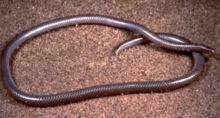Leptotyphlops humilis
| Leptotyphlops humilis | |
|---|---|
 |
|
| Scientific classification | |
| Kingdom: | Animalia |
| Phylum: | Chordata |
| Class: | Reptilia |
| Order: | Squamata |
| Suborder: | Serpentes |
| Family: | Leptotyphlopidae |
| Genus: | Leptotyphlops |
| Species: | L. humilis |
| Binomial name | |
|
Leptotyphlops humilis (Baird & Girard, 1853) |
|
| Synonyms | |
|
|
Leptotyphlops humilis is a blind snake species endemic to the southwestern United States and northern Mexico. Nine subspecies are currently recognized, including the nominate subspecies described here.
This species, like many of the others in this family, resembles a long earthworm. It lives underground in burrows, and since it has no use for vision, its eyes are mostly vestigial. The western blind snake is pink, purple, or silvery-brown in color, shiny, wormlike, cylindrical, and blunt at both ends, and has light-detecting black eyespots. The snake's skull is thick to permit burrowing, and it has a spine at the end of its tail that it uses for leverage. It is usually less than 30 cm (12 in) in total length (tail included), and is as thin as an earthworm. This species and other blind snakes are fluorescent under low frequency ultraviolet light (black light).
On the top of the head, between the ocular scales, L. humilis has only one scale (L. dulcis has three scales).
Western slender blind snake, western threadsnake, western blind snake.
It is found in the southwestern United States, South Florida, and northern Mexico. In the US it ranges from southwestern and Trans-Pecos Texas west through southern and central Arizona, southern Nevada, southwestern Utah, and southern California. In Mexico its distribution includes the Mexican states of Baja California, Sonora, Sinaloa, Nayarit, Jalisco, Colima, Chihuahua, Durango, Coahuila, Tamaulipas, and San Luis Potosí.
...
Wikipedia
